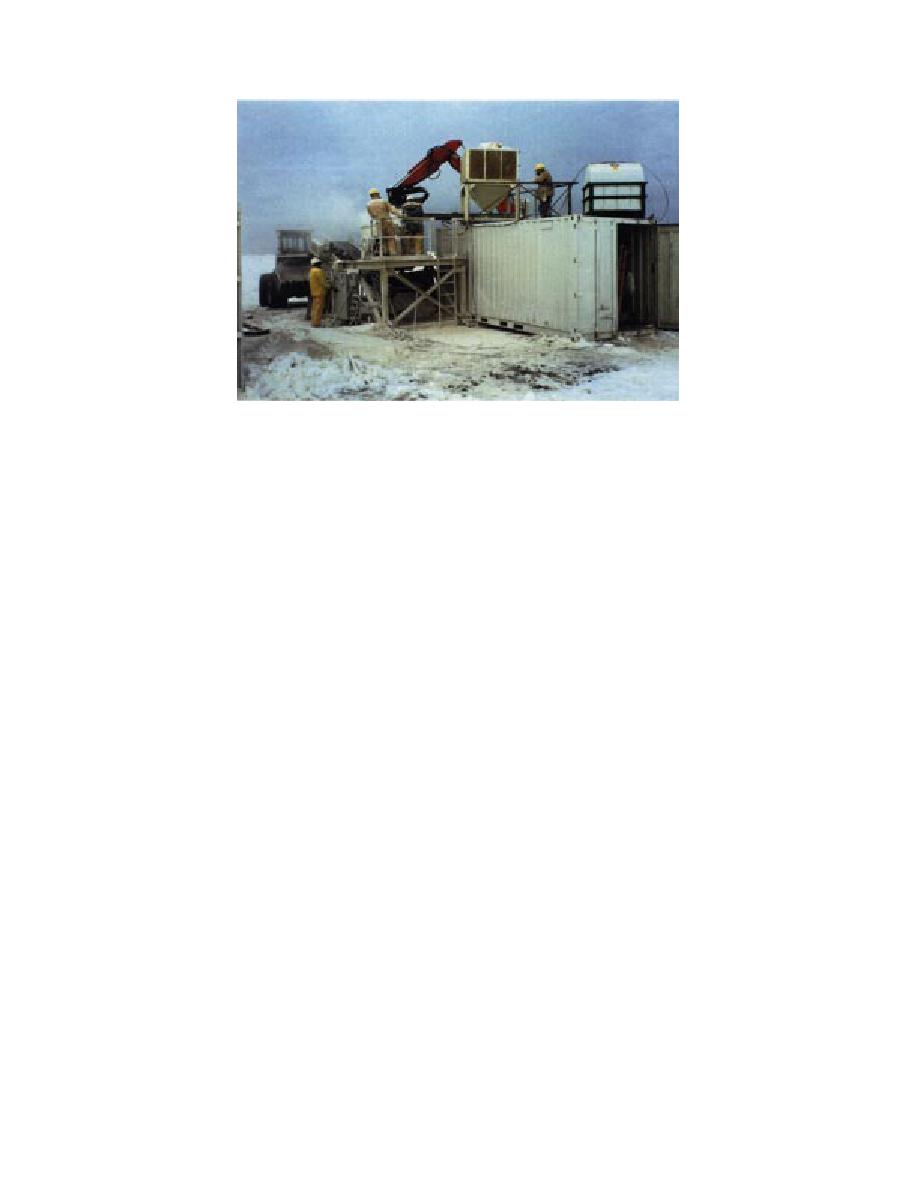
Lime-feed
Apparatus
Water
Mixer
↓
Conveyor
↓
↓
Control Panel
Figure 1. Transportable treatment unit used on the Shemya study.
Shemya Island is dominated by a persistent
is contaminated with JP4 and other volatile
low pressure system known as the "Aleutian
fuels; and 3) Fire Training Pit, which is contamin-
Low." Frequent storms track across the north
ated with diesel residuals that were not volatil-
Pacific into the Aleutian Islands. The Aleutian
ized or burned during fire training exercises.
low pressure cells are responsible for the relative-
SOUND Environmental Services (now known
ly mild maritime climate of the Aleutian Islands.
as SOUND/epic), Anchorage, Alaska, under con-
Summer fogs are severe and preclude any flying
tract with the U.S. Army Cold Regions Research
as often as one day in four. The persistent wind,
and Engineering Laboratory (CRREL), demon-
fog, and salt spray are responsible for the highly
strated the DCR technology at Eareckson AFS,
corrosive and harsh conditions.
Shemya. To treat the asphalt tar waste, SOUND
The mean annual temperature is 3.6C. The
used a skid-mounted transportable treatment
minimum and maximum recorded temperatures
unit (Fig. 1). The transportable treatment unit
are 13.9 and 17.2C, respectively. The diurnal
consists of a control panel, mixer, lime-feed appa-
temperature variation rarely exceeds 6C. Mea-
ratus, water container, and conveyer assemblies.
surable winds are recorded 363 days yr1 with a
Asphalt tar was excavated with a Link-Belt exca-
mean annual wind velocity of 32 km hr1. Wind
vator and stockpiled on the site. The excavated
direction is evenly distributed without any true
asphalt tar material and accompanying soil were
prevailing wind direction. Precipitation occurs
added to the pug-mill mixer on a volumetric basis.
more than 330 days yr1. Average annual precipi-
Lime was metered into the mixer on a timed basis
tation is 79.5 cm. The average annual snowfall is
dependent on the volume of waste addition.
178 cm. Drifting snow and driving rain are com-
Occasionally water was also added to the mixture
mon in winter because of strong wind velocities
at the discretion of the mixing overseer.
(CH2M Hill 1990).
Two bulk soil samples (18 kg each) for labora-
Eareckson AFS has several types of soil con-
tory physical tests were collected by mixing dif-
tamination problems which are the result of his-
ferent batches of DCR-treated asphalt material in
toric and ongoing USAF operations. The primary
the field. These samples were air-freighted to
focus of this study was on a site identified as the
CRREL without any special provisions for preser-
PS-9 Asphalt Tar Drum Storage Area. This site is
vation. Three soil samples were used in the phys-
contaminated as a result of leaked asphalt tar
ical tests. Samples 1 and 2 were from the two sep-
stored in 55-gal. drums. In addition, we exam-
arate buckets, and sample 3 was a composite
ined, at the laboratory scale, the efficacy of the
sample from the two buckets.
DCR process to remediate organic-contaminated
ASTM Method D 508490 was used to deter-
soil from three sites identified as 1) Oil/Water
mine the saturated hydraulic conductivity (per-
Separator Pond Sediment, which is contaminated
meability) of DCR-treated asphalt tar materials
with oils and greases; 2) Cell 21 Oiled Peat, which
before and after one freezethaw cycle. Rocks
4



 Previous Page
Previous Page
